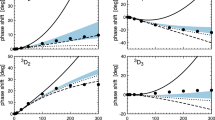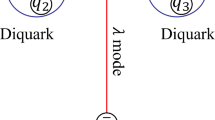Abstract
We describe the relativistic interacting quark–diquark model formalism and its application to the calculation of strange and nonstrange baryon spectra. The results are compared to the existing experimental data. We also discuss the application of the model to the calculation of other baryon observables, like baryon magnetic moments, open-flavor strong decays and baryon masses with self-energy corrections.
Similar content being viewed by others
References
Jakob, R., Mulders, P.J., Rodrigues, J.: Modelling quark distribution and fragmentation functions. Nucl. Phys. A 626, 937 (1997)
Jaffe, R.L., Wilczek, F.: Diquarks and exotic spectroscopy. Phys. Rev. Lett. 91, 232003 (2003)
Wilczek, F.: Diquarks as inspiration and as objects. arXiv:hep-ph/0409168
Jaffe, R.L.: Exotica. Phys. Rep. 409, 1 (2005)
Santopinto, E.: An interacting quark–diquark model of baryons. Phys. Rev. C 72, 022201 (2005)
Selem, A., Wilczek, F.: Hadron systematics and emergent diquarks. arXiv:hep-th/0602128
Ferretti, J., Vassallo, A., Santopinto, E.: Relativistic quark–diquark model of baryons. Phys. Rev. C 83, 065204 (2011)
Santopinto, E., Ferretti, J.: Strange and nonstrange baryon spectra in the relativistic interacting quark-diquark model with a Gürsey and Radicati-inspired exchange interaction. Phys. Rev. C 92, 025202 (2015)
De Sanctis, M., Ferretti, J., Santopinto, E., Vassallo, A.: Relativistic quark-diquark model of baryons with a spin-isospin transition interaction: non-strange baryon spectrum and nucleon magnetic moments. Eur. Phys. J. A 52, 121 (2016)
Klink, W.H.: Relativistic simultaneously coupled multiparticle states. Phys. Rev. C 58, 3617 (1998)
Gell-Mann, M.: A schematic model of baryons and mesons. Phys. Lett. 8, 214 (1964)
Ida, M., Kobayashi, R.: Baryon resonances in a quark model. Prog. Theor. Phys. 36, 846 (1966)
Lichtenberg, D.B., Tassie, L.J.: Baryon mass splitting in a boson-fermion model. Phys. Rev. 155, 1601 (1967)
Gursey, F., Radicati, L.A.: Spin and unitary spin independence of strong interactions. Phys. Rev. Lett. 13, 173 (1964)
Olive, K.A., et al.: [Particle Data Group]. Review of particle physics. Chin. Phys. C 38, 090001 (2014)
Isgur, N., Karl, G.: P wave baryons in the quark model. Phys. Rev. D 18, 4187 (1978)
Isgur, N., Karl, G.: P positive parity excited baryons in a quark model with hyperfine interactions. Phys. Rev. D 19, 2653 (1979)
Capstick, S., Isgur, N.: Baryons in a relativized quark model with chromodynamics. Phys. Rev. D 34, 2809 (1986)
Ferraris, M., et al.: A three body force model for the baryon spectrum. Phys. Lett. B 364, 231 (1995)
Aiello, M., et al.: A three body force model for the electromagnetic excitation of the nucleon. Phys. Lett. B 387, 215 (1996)
Giannini, M.M., Santopinto, E.: The hypercentral constituent quark model and its application to baryon properties. Chin. J. Phys. 53, 020301 (2015)
Glozman, L.Y., Riska, D.O.: The spectrum of the nucleons and the strange hyperons and chiral dynamics. Phys. Rep. 268, 263 (1996)
Loring, U., Metsch, B.C., Petry, H.R.: The light baryon spectrum in a relativistic quark model with instanton induced quark forces: the nonstrange baryon spectrum and ground states. Eur. Phys. J. A 10, 395 (2001)
Galatà, G., Santopinto, E.: Hybrid quark–diquark baryon model. Phys. Rev. C 86, 045202 (2012)
Gutierrez, C., De Sanctis, M.: A study of a relativistic quark–diquark model for the nucleon. Eur. Phys. J. A 50, 169 (2014)
Faustov, R.N., Galkin, V.O.: Strange baryon spectroscopy in the relativistic quark model. Phys. Rev. D 92, 054005 (2015)
De Sanctis, M., Ferretti, J., Santopinto, E.: Nucleon electromagnetic form factors and helicity amplitudes of baryon resonances in the interacting quark-diquark model. (Unpublished)
Micu, L.: Decay rates of meson resonances in a quark model. Nucl. Phys. B 10, 521 (1969)
Le Yaouanc, A., Oliver, L., Pene, O., Raynal, J.-C.: Naive quark pair creation model of strong interaction vertices. Phys. Rev. D 8, 2223 (1973)
Le Yaouanc, A., Oliver, L., Pene, O., Raynal, J.-C.: Naive quark pair creation model and baryon decays. Phys. Rev. D 9, 1415 (1974)
Roberts, W., Silvestre-Brac, B.: General method of calculation of any hadronic decay in the \(^3P_0\) model. Few-Body Syst. 11, 171 (1992)
García-Tecocoatzi, H., Bijker, R., Ferretti, J., Santopinto, E. arXiv:1603.07526
Ferretti, J., Galatà, G., Santopinto, E.: Interpretation of the \(X(3872)\) as a charmonium state plus an extra component due to the coupling to the meson-meson continuum. Phys. Rev. C 88, 015207 (2013)
Bijker, R., Ferretti, J., Galatà, G., García-Tecocoatzi, H., Santopinto, E. arXiv:1506.07469
Ackleh, E.S., Barnes, T., Swanson, E.S.: On the mechanism of open flavor strong decays. Phys. Rev. D 54, 6811 (1996)
Author information
Authors and Affiliations
Corresponding author
Rights and permissions
About this article
Cite this article
De Sanctis, M., Ferretti, J., Magaña Vsevolodovna, R. et al. An Interacting Quark–Diquark Model. Few-Body Syst 57, 1177–1184 (2016). https://doi.org/10.1007/s00601-016-1139-4
Received:
Accepted:
Published:
Issue Date:
DOI: https://doi.org/10.1007/s00601-016-1139-4




